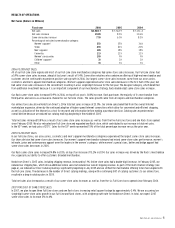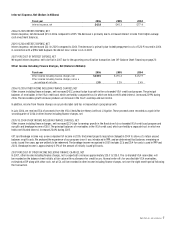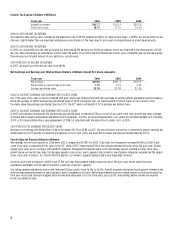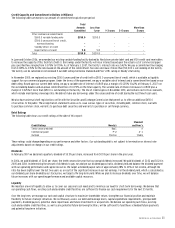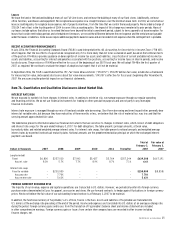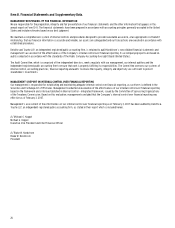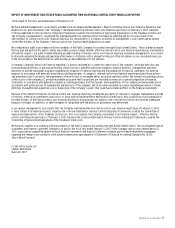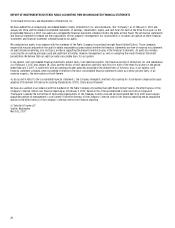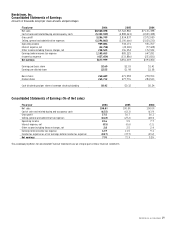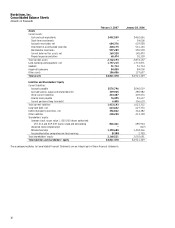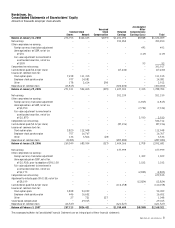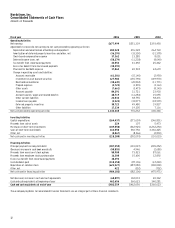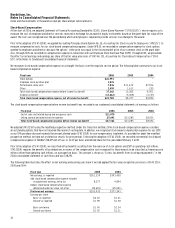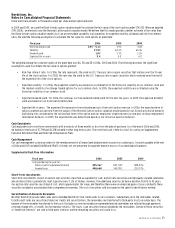Nordstrom 2006 Annual Report Download - page 43
Download and view the complete annual report
Please find page 43 of the 2006 Nordstrom annual report below. You can navigate through the pages in the report by either clicking on the pages listed below, or by using the keyword search tool below to find specific information within the annual report.
Nordstrom, Inc. and subsidiaries 25
Leases
We lease the land or the land and building at many of our Full-Line stores, and we lease the building at many of our Rack stores. Additionally, we lease
office facilities, warehouses and equipment. We recognize lease expense on a straight-line basis over the minimum lease term. In 2004, we corrected our
lease accounting policy to recognize lease expense, net of property incentives, from the time that we control the leased property. We recorded a charge of
$7.8 ($4.7 net of tax) in the fourth quarter of 2004 to correct this accounting policy. The impact of this change was immaterial to prior periods. Many of
our leases include options that allow us to extend the lease term beyond the initial commitment period, subject to terms agreed to at lease inception. For
leases that contain rent holiday periods and scheduled rent increases, we record the difference between the rent expense and the rental amount payable
under the leases in liabilities. Some leases require additional payments based on sales and are recorded in rent expense when the contingent rent is probable.
RECENT ACCOUNTING PRONOUNCEMENTS
In July 2006, the Financial Accounting Standards Board (FASB) issued Interpretation No. 48,
Accounting for Uncertainty in Income Taxes
(“FIN 48”),
which requires that the tax effects of a position be recognized only if it is more likely than not to be sustained on audit, based on the technical merits
of the position. FIN 48 also provides guidance on derecognition of income tax assets and liabilities, classification of current and deferred income tax
assets and liabilities, accounting for interest and penalties associated with tax positions, accounting for income taxes in interim periods, and income
tax disclosures. The provisions of FIN 48 are effective for us as of the beginning of our 2007 fiscal year. We will adopt FIN 48 in the first quarter of
2007, as required. We continue to evaluate the impact of adoption, but expect that it will not be material.
In September 2006, the FASB issued Statement No. 157,
Fair Value Measurements
(“SFAS 157”). SFAS 157 defines fair value, establishes a framework
for measuring fair value, and expands disclosures about fair value measurements. SFAS 157 is effective for fiscal years beginning after November 15,
2007. We are assessing the potential impact on our financial statements.
Item 7A. Quantitative and Qualitative Disclosures About Market Risk.
INTEREST RATE RISK
We are exposed to market risk from changes in interest rates. In seeking to minimize risk, we manage exposure through our regular operating
and financing activities. We do not use financial instruments for trading or other speculative purposes and are not party to any leveraged
financial instruments.
Interest rate exposure is managed through our mix of fixed and variable rate borrowings. Short-term borrowing and investing activities generally bear
interest at variable rates, but because they have maturities of three months or less, we believe that the risk of material loss was low, and that the
carrying amount approximated fair value.
The table below presents information about our financial instruments that are sensitive to changes in interest rates, which consist of debt obligations
and interest rate swaps for the year ended February 3, 2007. For debt obligations, the table presents principal amounts, at book value,
by maturity date, and related weighted average interest rates. For interest rate swaps, the table presents notional amounts and weighted average
interest rates by expected (contractual) maturity dates. Notional amounts are the predetermined dollar principal on which the exchanged interest
payments are based.
Dollars in thousands
2007
2008
2009
2010
2011
Thereafter
Total at
February 3,
2007
Fair value at
February 3,
2007
Long-term debt
Fixed
$6,800
$257,030
$7,043
$5,427
$5,764
$357,244
$639,308
$667,191
Avg. int. rate
8.0%
5.7%
7.7%
8.9%
8.7%
7.1%
6.6%
Interest rate swap
Fixed to variable
—
$250,000
—
—
—
$250,000
$(8,858)
Avg. pay rate
—
7.70%
—
—
—
7.70%
Avg. receive rate
—
5.63%
—
—
—
5.63%
FOREIGN CURRENCY EXCHANGE RISK
The majority of our revenue, expense and capital expenditures are transacted in U.S. dollars. However, we periodically enter into foreign currency
purchase orders denominated in Euros for apparel, accessories and shoes. We use forward contracts to hedge against fluctuations in foreign currency
prices. We do not believe the fair value of our outstanding forward contracts at February 3, 2007 to be material.
In addition, the functional currency of Façonnable, S.A.S. of Nice, France is the Euro. Assets and liabilities of Façonnable are translated into
U.S. dollars at the exchange rate prevailing at the end of the period. Income and expenses are translated into U.S. dollars at an average exchange rate
during the period. Foreign currency gains and losses from the translation of Façonnable’s balance sheet and income statement are included
in other comprehensive earnings. Foreign currency gains or losses from certain intercompany loans are recorded in other income including
finance charges, net.


